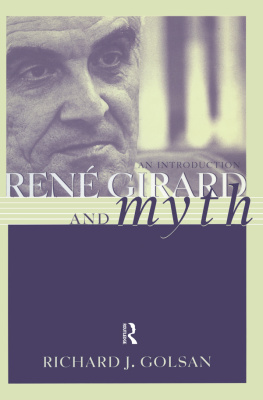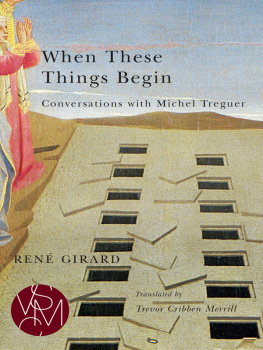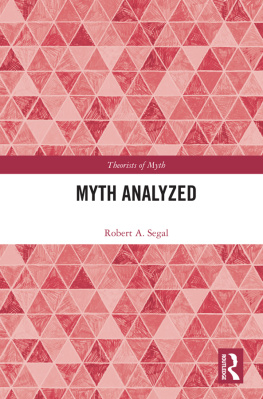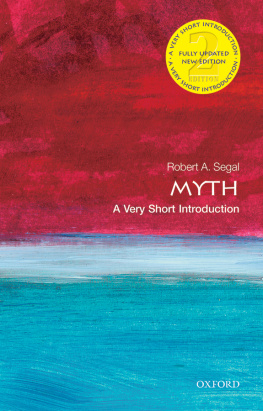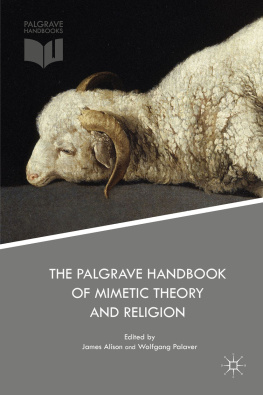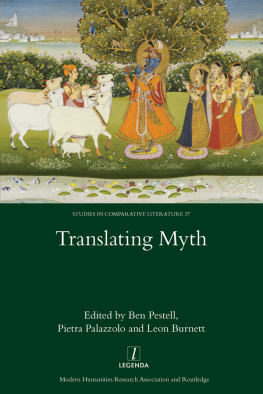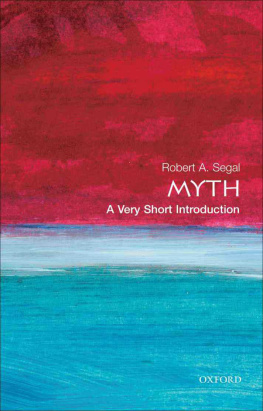REN GIRARD AND MYTH
Theorists of Myth
Robert A. Segal, Series Editor
Jung and the Jungians on Myth
An Introduction
by Steven F. Walker
Political Myth
A Theoretical Introduction
by Christopher G. Flood
The Poetics of Myth
by Eleazar M. Meletinsky
translated by Guy Lanoue and Alexandre Sadetsky
Northrop Frye on Myth
An Introduction
by Ford Russell
Cassirer and Langer on Myth
An Introduction
by William Schultz
Forthcoming in paperback:
Myth and Religion in Mircea Eliade
by Douglas Allen
The Myth and Ritual School:
J. G. Frazier and the Cambridge Ritualists
by Robert Ackerman
REN GIRARD AND MYTH
An Introduction
Richard J. Golsan
Published in 2002 by
Routledge
711 Third Avenue,
New York, NY 10017, USA
Published in Great Britain by
Routledge
2 Park Square, Milton Park,
Abingdon, Oxon OX14 4RN
Routledge is an imprint of the Taylor & Francis Group, an informa business
Copyright 1993 by Richard J. Golsan
All rights reserved. No part of this book may be reprinted or by any electronic, mechanical or other means, now known or hereafter invented, including photocopying and recording or in any information storage or retrieval system, without permission in writing from the publishers.
ISBN 0-415-93777-9
Library of Congress Cataloging-in-Publication Data available from the Library of Congress.
To Nancy,
Te voyant rire avecques si grande grace ce doulx soubris me donne espoir de vie.
Maurice Scve
TABLE OF CONTENTS
Most of the major theorists of myth are dead, and the theories of few of those alive are still being developed. Ren Girard, the expatriate Frenchman by now long resident in the United States, is, happily, one of those few. While he began developing his theory of myth in the early 1970s, it is especially in the last decade or so that he has truly come into his own. Not only books but entire issues of journals and conferences have focused on his work, and even a whole journal devoted to his ideas has appeared. Yet because his theory is, as theories of myth go, budding, there has barely been sufficient opportunity to offer an overview of his ideas.
Richard Golsan provides that first overview, and he does so both lucidly and thoroughly. Golsan treats Girard as a literary critic, as a biblical critic, as a critic of psychoanalysis, as a critic of structuralism, and as a culture critic. But he treats him as a myth critic above all. Golsan traces the development of Girards theory out of his literary criticism and traces its extension into his criticism of modern life per se, but he concentrates foremost on Girards view of myth. Golsan uses cases of classical, biblical, and literary myths to illustrate the ideas for which Girard has become famous: those of mimetic desire and scapegoating most of all. Golsan shows how for Girard the history of culture evolves from myths to persecution texts to post-mythic narratives. Most helpfully, Golsan compares Girards view of myth with the views of Sigmund Freud and Claude Lvi-Strauss, who are perhaps the two leading twentieth-century theorists of myth.
While Golsan considers himself a Girardian, he is by no means an uncritical devotee. In his final chapter he presents unflinchingly the major criticisms of Girard that have been lodged and does not seek to dismiss them. While his respect for Girards accomplishments remains transparent, his respect is, if anything, enhanced by his willingness to subject Girard to scrutiny. He assesses not only the applicability of Girards theory to myths and other texts but also the cogency of the theory in its own right
As a whole, Golsans book gives a fair as well as comprehensive introduction to one of the most original and provocative of recent efforts at theorizing about myth.
The following abbreviations have been used in making reference to works by Ren Girard All translations from texts in French are my own:
| Deceit | Deceit, Desire, and the Novel. Trans. Yvonne Freccero. Baltimore: Johns Hopkins U. P., 1966. |
| Dostoevski | Dostoevski, du double lunit in Critiques dans un souterrain. Paris: Grasset, 1976. 41-135. |
| double business | To double business bound: Essays on Literature, Mimesis, and Anthropology. Baltimore: Johns Hopkins U. P., 1978. |
| Generative | Generative Scapegoating in Violent Origins: Ritual Killing and Cultural Formation. Ed. Robert G. Hamerton-Kelly. Stanford: Stanford U. P., 1987. 73-105. |
| Innovation | Innovation and Repetition. Substance 62/63, 7-20. |
| Job | Job, the Victim of His People. Trans. Yvonne Freccero. Stanford: Stanford U. P., 1987. |
| Origins | Origins: A View From the Literature in Understanding Origins: Contemporary Views on the Origin of Life, Mind, and Society. Eds. Francisco Varela and Jean-Pierre Dupuy. Dordrecht: Kluwer Academic Publishers, 1992. 27-44. |
| Theater | A Theater of Envy: William Shakespeare. New York: Oxford University Press, 1991. |
| Theory | Theory and Its Terrors in The Limits of Theory. Ed. Thomas Kavanagh. Stanford: Stanford U. P., 1989. 225-254. |
| Things Hidden | Things Hidden since the Foundation of the World. Trans. Stephen Bann and Michael Metteer. Stanford: Stanford U. P., 1987. |
Ren Girard is undoubtedly one of the most interesting and controversial of the great French critics to have emerged during the 1960s and 1970s. His research spans the fields of literary criticism, anthropology, psychology, and theology, and in all of these areas he has left his mark. Admirers and critics alike have taken up his ideas either to apply them in their own work or to challenge their validity. Assessments of Girards contributions are, moreover, rarely dispassionate. He has at once been described as one of the major thinkers of the centurys last third and has justly earned the reputation of possessing a combative as well as a fertile mind.
For all the controversy it has generated, Girards thought is straightforward and accessible. Two ideas are crucial. First, Girard asserts that desire is imitative, or mimetic, rather than innate: human beings copy their desires from each other. Second, Girard argues that cultural and social order sprang from acts of unanimous, sacrificial violence against innocent victims, or scapegoats. In exploring the ramifications of these ideas in disciplines throughout the humanities and social sciences, Girard has elaborated a psychology of mimetic desire which he labels interdividual, and he has reinterpreted the function and meaning of rites and rituals in primitive cultures. At the same time he has offered provocative analyses of literary masterpieces from Greek tragedy to Shakespeare to the great novels of the nineteenth and twentieth centuries. Girard has also proposed startling rereadings of biblical texts and has accorded them a controversial and privileged status in the development of Western culture. Finally, and most importantly here, Girard has redefined myth in a productive and comprehensive fashion.
The present study is intended to provide a critical introduction to Ren Girards work, focusing ultimately on his theory of myth. Chapter one, From Triangular Desire to Interdividual Psychology, examines the theory of mimetic desire in a literary and psychological context Chapter two, Sacrificial Violence and Scapegoat, examines the role of scapegoating in social and cultural formation through a discussion of literary texts from Greek tragedy to the modern French novel as well as through analyses of the rites and rituals of primitive peoples. Chapter three is devoted to Girards theory of myth and contextualizes the theory in relation to the work of other mythologists, including Claude Lvi-Strauss and Otto Rank. Girards reading of the Bible and his assessment of its impact on Western culture are the subject of chapter four. As its title suggests, the final chapter of this study examines the major criticisms of Girards theories and briefly discusses some of the research in different fields which his ideas have inspired.
Next page
